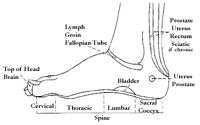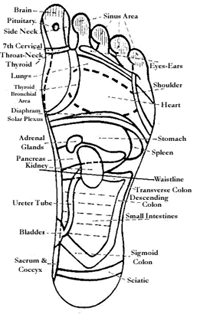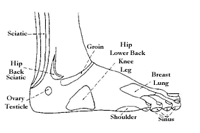| ||||||||||||||||||||
Feel
the Qi.com
Back
to Introductory Qigong Articles | Practices
Practices: Self-Applied Massage
© Roger Jahnke O.M.D.
Every original culture on the planet earth has a system of "hands on" healing. In western cultures this is generally called massage. However, there are many named systems including reflexology, Swedish massage, connective tissue manipulation, trigger point therapy, zone therapy and polarity. As the movement toward alternatives to drugs and surgery progress massage will energy as one of our primary new, while actually ancient, therapeutic modalities. Hospitals, and even corporations, are hiring massage therapists to help with healing and to prevent the negative impacts of stress.
Massage can be self applied very effectively. Trigger points, points or areas of pain appear throughout the body when a person is unwell. Some of the points are directly in the area of the problem and others appear at a distance to the problem and are known as reflexes. A reflex is two separated areas that are in a relationship in the body. Rubbing and exerting pressure on these points has been found over the centuries, to have a positive effect on the healing process. While it is always the most fun to have this done for you by someone else, it is possible and very effective to do it for yourself. It can be done at any time of the day or night with no travel and no expense.
The success of self applied massage is variable. In some cases it is very subtle and the practitioner (that is you) may have to be patient over a period of time. However, in many cases the results are dramatic. One such case was a woman whose profession was music. She is a piano teacher with many talented students whose services were in great demand. She attended conferences, organized conferences, gave lectures and was a judge at competitions. Over a number of years she had an increasing problem with frequency of urination.
As the problem became more severe she began to experience terrible spasms of her bladder. She was forced to cut back on much of her professional life. She had to urinate 4-5 times during a piano lesson. She had to sit at the back of the conferences so she could make multiple bathrooms trips. The pain of the spasm began to keep her from traveling. Eventually she was forced to a minimal level of participation in many of her very favorite activities.
She was told that in addition to acupuncture, herbal formulas and some body therapy she would improve more quickly with the self applied health enhancement methods (SAHEM). She immediately and fervently began practicing breathing and relaxation techniques. She was told that if she found and rubbed the correct point in her eat that it could be of great benefit.
One day upon her arrival at the Health Action clinic she announced, "Eureka, I found the point. When I rub the ear point the spasm and the pain scatter". With vigilant application of this and the other methods she is back to her original lifestyle. Of course, it is her original and beloved professional music activities plus the self applied health enhancement methods (SAHEM).
While there are many techniques of self massage, the preliminary approach is the application of pressure to the reflexes of the ears, hands and feet. These are called microsystems. A microsystems is an area of the body that is a small representation of the whole body. It has been found through thousands of years of experienced that the ears, hands and feet are such areas. Each part of the whole body has a reflex on the ear, on the hand and on the foot. The iris of the eye is also a microsystems are linked through the brain and nervous system.
When the whole body was just a few cells in size, during its first few hours of life, it carried within it the potential for a mature, full sized self. As growth occurred the extremities carried the imprint of the whole system with them, as nerves and other tissues, as they grew in size. As the organ systems grew they too carried their relationship of the microsystems to all of the body's parts and functions. By stimulating the microsystems one can stimulate the related body parts and organs.
This is a powerful healing tool. The greatest first impulse when there is pain and suffering is to reach out and touch in a helping way. This impulse was translated in the earliest humans into massage. The self application of this healing tool, as you might guess, is one of the most ancient, tried and true of the healing arts. There is not a good reason for why every person is not using this tool on a regular basis. The history of science has tended to carry us away from ourselves and to emphasize expensive technological solutions. We are now through that part of our history. There is every reason why every person should learn and use the methods of self-applied massage and share them.
1. Self-Applied Massage of the Feet
 The toes
and ball of the foot are reflex to the upper part of the body. The central
area of the arch is reflex to the torso. The heal is related to the parts
of the body below the waist. While it is interesting to know what each
aspect of the foot is reflex to, it is not important to the outcome of
the therapy. Please do not sabotage the whole body benefits that you can
receive from the application of massage to your to your feet by needing
to know what each sore area represents. Find the sore points and work
on them, keep it simple.
The toes
and ball of the foot are reflex to the upper part of the body. The central
area of the arch is reflex to the torso. The heal is related to the parts
of the body below the waist. While it is interesting to know what each
aspect of the foot is reflex to, it is not important to the outcome of
the therapy. Please do not sabotage the whole body benefits that you can
receive from the application of massage to your to your feet by needing
to know what each sore area represents. Find the sore points and work
on them, keep it simple. 
First do pressure massage over the entire foot. Usually the bottom of the foot is the primary focus; however, the top of the foot and the ankle area are rich with reflexes as well. As you are massaging the whole foot note areas of particular tenderness.
Come back and work specifically on the tender areas. These are the reflexes that need it the most. Stimulating them and working out the soreness will help the organs, glands and tissues that are associated through the reflex mechanism to function in a more way.
 Generally
the pressure is applied by the thumbs. It will take a while to build up
your thumbs. Alternate the techniques for pressure application by using
bunched, extended fingers, the knuckles, the heel of the hand or a gripping
motion where the whole hand provides the force for pressing inward with
the four fingers.
Generally
the pressure is applied by the thumbs. It will take a while to build up
your thumbs. Alternate the techniques for pressure application by using
bunched, extended fingers, the knuckles, the heel of the hand or a gripping
motion where the whole hand provides the force for pressing inward with
the four fingers.
Start with light pressure and work up to substantial pressure. Imagine the pressure necessary to impress a new tennis ball or the force necessary to pick up a brick between your thumb and index finger. These are images to give you guidance on the amount of pressure necessary. If it hurts, back off. Notice that over a few days generally the amount of soreness will change.
2. Self-Applied Massage of the Hands
 The basic
technique of self-applied massage for the hands is the same as for the
feet. However, the hands are much easier because they are so easy to reach.
Without sitting down or having to remove your shoes you can go right to
work. You can do this any where at any time. You probably have seen the
robes with large sleeves that the Chinese wear in pictures of ancient
times.
The basic
technique of self-applied massage for the hands is the same as for the
feet. However, the hands are much easier because they are so easy to reach.
Without sitting down or having to remove your shoes you can go right to
work. You can do this any where at any time. You probably have seen the
robes with large sleeves that the Chinese wear in pictures of ancient
times.
Often the person is shown with their hands held at about the level of the abdomen, tucked inside the sleeves. You have probably asked yourself, "Why do they do that: What are they doing with their hands?" Certainly not always, but sometimes they are doing hand massage.
There are certain ancient theories in Chinese medicine that link areas of the hands to particular organs and functions. In one system associated with the ancient classic of philosophy, the I Ching, the palm of the hand depicted as a bowl with the aspects of nature around its interior.
In the self-applied massage of the hands the system is far from esoteric. Massage your hands all over with firm pressure. Notice areas of tenderness. Return to the tender areas and administer firm pressure for a few minutes. These tender areas are associated with organs and functions that are not operating at their most healthy levels.
In a series of workshops on self-massage I have asked people to find the most tender area on their hand. Each person, in turn, described the area. I would, at this point, make an educated guess as to what body area or function they had their primary health problem with. In nearly 100% of the cases the tender area that the individual described led to an accurate "educated" guess of their primary health problem This has surprised even me!
3. Self-Applied Massage of the Ears
The traditional systems of medicine from the Asian cultures have always had some type of massage stimulation to the ears. When you work on your ears you will notice that within 4-5 minutes of vigorous massage your ears get hot. This is cause by the increase of blood flow to that area.
The Chinese say, "When the blood is increased to an area the Energy (Qi) is increased to that area as well." If you have someone else rub your ears you will notice that your ears are extremely sensitive. The combination of the presence of the nerve, the effect of the pressure and the heightened circulation causes stimulation to the reflexes of the microsystems of the ear. Through this reflex microsystems all parts of the body can be influenced through pressure massage to the ear.
In the critical disease of addiction to alcohol and to drugs the emerging treatment of choice is acupuncture. This is a wonderful breakthrough because the former treatment of choice was drugs. It is ironic and sad that our best technique to detoxify addicts from drugs was more drugs. The drug treatment happened in extremely expensive treatment facilities; whereas, the acupuncture treatment is effective for most people in a completely out patient setting. This is a revolution in health care.
The acupuncture points for this treatment are all in the ears. I use this example here because it is fascinating to note the extent to which treatment of the ear reflexes trigger powerful healing mechanisms in the human body. Research has shown that at least one way in which the stimulation of ear reflexes works is through the activity of the brain chemistry, specially the neurotransmitters. Acupuncture or pressure stimulation of the ear reflexes stimulates the productivity of important neurotransmitters.
One of our patients at the Health Action Clinic had an unusual pain that was caused by the contraction of his prostate gland. Sometimes this painful contractions would occur after sex. Occasionally, it would occur spontaneously. It was very painful and would last for hours. He was very much against the use of drugs. He tried relaxation, hot beverages, yoga and shifting to many different positions. He also felt that acupuncture and herbal formulas were helpful in regulating his health, in general. What gave him the most direct relief of the intense pain in his prostate was self-applied massage of the ear. Within 5 minutes of vigorous massage to the whole ear and about two minutes of massage to the prostate reflex the pain would ease and disappear.
Massage of the ear is similar to massage of the foot and hand. Begin with moderate pressure and work over the entire ear on both sides. Notice areas of discomfort. Return and work the uncomfortable areas vigorously. This may not bring immediate results as in the two examples given. Vigilant application of self-applied massage over long periods of time has helped many people to overcome serious health disorders.
